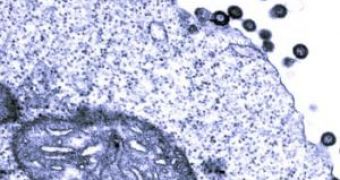Retroviruses are RNA based viruses that possess an unusual trait: they can be added as genetic material to our genome.
The infamous HIV is a retrovirus but while HIV accompanies us by less than 40 years, others have come along with us during our whole evolution, some gone extinct by thousands or millions of years, but many of them left a fossil print ...in our own DNA!
In fact, during many millions of years of evolution, this DNA has reached to represent 8 % of the total DNA we carry. When infecting a cell, retroviruses first induce a replication of their RNA to DNA.
This DNA, in contact to integrase enzyme can be added to the host cell's genome and if this occurs in a germ cell (a sperm or an ovule), the retroviral DNA will be inherited by offspring just like a normal gene.
Recently, a team succeeded to bring back to life one of those retroviruses. "In our DNA, there's a fossil record of retroviruses that used to infect us," says Paul Bieniasz, associate professor and head of the Laboratory of Retrovirology at Rockefeller University and the Aaron Diamond AIDS Research Center.
The retroviruses embedded in our DNA can't induce infections due to mutations in their genes; however, the later they entered the human genome, the lower the number of these mutations in human endogenous retroviruses (or HERVs) is.
One subfamily, HERV-K, is believed to have been still active less than a few hundred thousand years ago.
To eliminate the mutations, the team realized a whole viral DNA from scratches, using 10 different HERV-K proviruses. The new virus was able to infect human cells, inducing the synthesis of viral proteins and DNA. "This is the first time this has been done with a viral genome that was effectively dead, and now is alive - or at least has all the functions that suggest it should replicate," said Bieniasz. "The project began because certain human and non-human primate cells produce proteins that appear to block HIV from replicating. And the question is where did the proteins come from?" said Youngnam Lee, a graduate student. "By studying these extremely old viruses, we can tap into what happened in our ancestors millions and millions of years ago."
Image credit: Rockefeller University. Human cells expressing structural proteins from the resurrected retrovirus, HERV-KCON, build retrovirus-like particles and release them from the cell membrane, just as cells infected with a true retrovirus do.

 14 DAY TRIAL //
14 DAY TRIAL //